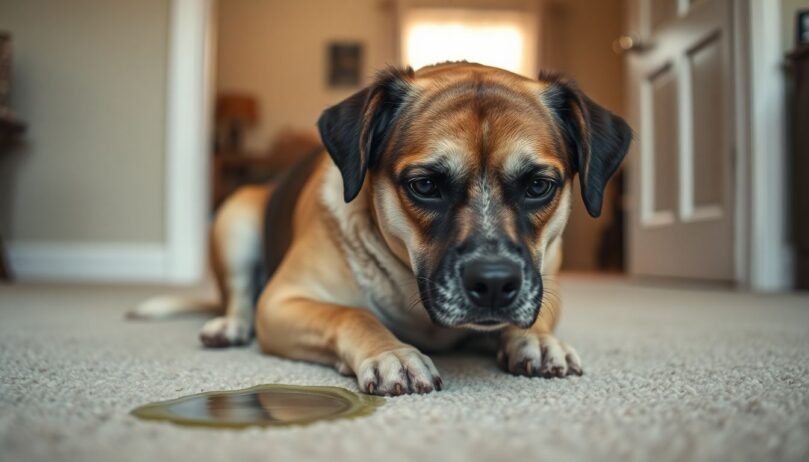Reasons Your Dog Is Peeing In The House
- 15 February 2025
- BuyAPet Editorial Team
- All Dogs, Dog Health
Why Is My Dog Peeing in the House? Common Causes & Solutions
Many owners face the frustration of indoor accidents. This guide breaks down medical, behavioural, environmental, and dietary reasons—plus practical steps to fix them and when to call the vet.
Medical Reasons for House Soiling
Urinary Tract Infections (UTIs)
UTIs are relatively common and can cause urgency and accidents. Watch for:
- Frequent attempts to urinate
- Straining or discomfort
- Blood in the urine
What to do: Book a vet visit for a urinalysis and targeted treatment.
Kidney Disease
Compromised kidney function leads to increased thirst and urination. Signs include:
- Increased drinking
- Weight loss
- Vomiting or lethargy
Tip: Early detection via blood/urine tests helps slow progression and manage symptoms.
Diabetes
High blood glucose causes increased thirst and urine volume. Look for:
- Increased thirst (polydipsia)
- Weight change
- Lethargy
What to do: See your vet—especially with senior dogs—for diagnostics and a management plan.
Behavioural Reasons for House Soiling
Submissive Urination
- Occurs during greetings, scolding, or when feeling intimidated
- Body language: lowered posture, tucked tail
Solution: Keep greetings calm, avoid punishment, reward confident behaviour.
Excitement Urination
- Triggered by visitors, play, or sudden noises
Solution: Enter calmly, cue “sit” for greetings, reward calmness, manage arousal levels.
Marking Behaviour
Small amounts in specific spots to claim territory.
- Neutering may reduce marking
- Use enzymatic cleaners and pheromone diffusers
- Increase supervision and block target areas
Environmental Factors Affecting House Training
Lack of Potty Training Consistency
- Keep a consistent schedule: morning, after meals, after play, before bed
- Use a cue word and reward immediately outside
Insufficient Access to Outdoors
- Provide regular breaks (puppies and seniors need more frequent trips)
- Consider a dog walker, daycare, or secure toilet area if you’re away
Stressful Home Environment
- New pets, renovations, routine changes can trigger accidents
- Create safe zones; maintain predictable routines
Dietary Factors and Their Role
Diet Changes
- Sudden switches can alter bowel/urine habits; transition over 7–10 days
- Monitor for diarrhoea or increased frequency
Water Consumption
- Hot weather, exercise, and some medicines increase thirst
- Always provide fresh water; note any sudden changes in drinking
Food Allergies & Sensitivities
- May present with itching or GI upsets alongside accidents
- Work with your vet on elimination diets if needed
When to Seek Professional Veterinary Help
- Blood in urine, pain, fever, or persistent accidents
- Lethargy, loss of appetite, weight loss
- No improvement despite consistent training
Urgent: Sudden inability to urinate is an emergency—contact a vet immediately.
Step-by-Step Action Plan
| Step | What to Do | Why it Helps |
|---|---|---|
| 1. Rule out medical issues | Vet check, urinalysis ± bloods | Identifies UTIs, diabetes, kidney disease |
| 2. Deep clean accidents | Use an enzymatic cleaner | Removes scent markers that trigger repeats |
| 3. Reset the routine | Timed potty breaks; reward outside | Rebuilds reliable toileting habits |
| 4. Manage indoors | Supervise, tether, or crate between breaks | Prevents rehearsing mistakes |
| 5. Reduce triggers | Calm greetings; pheromones; block marking spots | Lowers stress/excitement urination |
| 6. Track progress | Log water, meals, accidents, and wins | Reveals patterns; guides adjustments |
Disclaimer: This article is educational and not a substitute for personalised veterinary advice.
